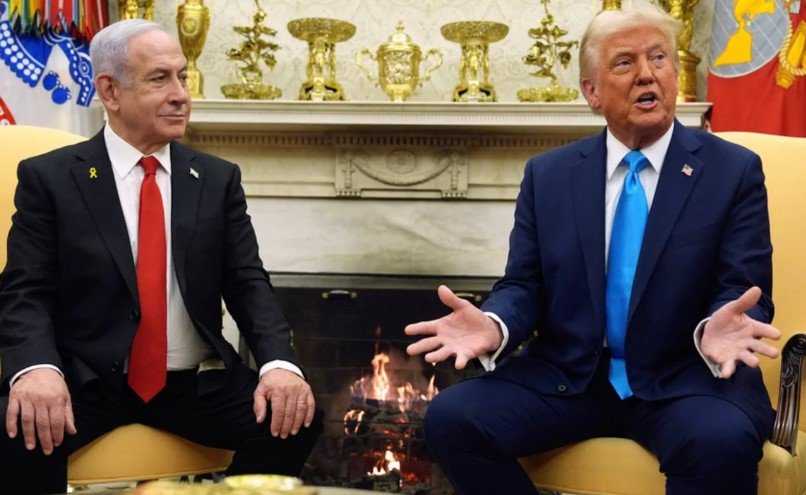President Trump Proposes Long-Term US Control Over Gaza for Regional Stability
In a bold statement during a bilateral meeting with Israeli Prime Minister Benjamin Netanyahu on February 5, 2025, U.S. President Donald Trump unveiled a controversial proposal to take control of the Gaza Strip, claiming it would be a “long-term ownership position” aimed at bringing “great stability” to the Middle East. The statement came during a press briefing at the White House, as the two leaders discussed the future of the region and the U.S.’s role in addressing ongoing tensions.
Trump’s Bold Proposal for Gaza: A “Long-Term Ownership Position”
President Trump’s proposal to assume control of Gaza shocked both political analysts and world leaders, with many questioning the feasibility and implications of such a move. According to Trump, the United States would not only take over Gaza but would also deploy U.S. troops to the region if necessary to maintain peace. The idea, which Trump described as a long-term commitment, aims to dismantle the existing infrastructure and weapons left behind by the ongoing conflict.
“We’ll own it and be responsible for dismantling all of the dangerous unexploded bombs and other weapons on the site,” Trump declared during the joint press conference, referring to the region’s volatile and dangerous environment. He further added that the U.S. would “level the site, get rid of the destroyed buildings, level it out, create an economic development that will supply unlimited numbers of jobs and housing for the people of the area.”

The plan, while lacking in specific details, suggests a significant shift in U.S. foreign policy, emphasizing a more hands-on approach in one of the world’s most contentious territories. The suggestion of U.S. ownership and direct intervention in Gaza is already drawing mixed reactions both domestically and internationally.
The Push for Stability in the Middle East
Trump’s argument for a U.S. takeover of Gaza is rooted in his broader vision for the Middle East. By asserting that the U.S. could bring “great stability” to the region, Trump emphasized that a more organized, controlled approach to the region would ensure long-term peace. For years, Gaza has been embroiled in conflict, particularly between Israeli forces and Palestinian militants, creating a chaotic and dangerous environment for the people living there.
While the U.S. has historically played a significant role in Middle Eastern diplomacy, this new proposal marks a dramatic escalation in U.S. involvement. Trump’s rhetoric implies that the responsibility of restoring Gaza lies primarily with the United States, rather than with international organizations or other regional powers. This could have far-reaching consequences, as other nations and political bodies may not welcome the idea of the U.S. taking such a central role in the region’s future.
The Impact on Israel-Palestinian Relations
For Prime Minister Netanyahu, the proposal aligns with Israel’s longstanding desire for greater international support in securing Gaza and eliminating hostile forces in the region. However, critics argue that Trump’s plan could further inflame tensions between Israel and Palestine, with Palestinian groups already expressing concerns over increased foreign intervention and the continued stagnation of peace negotiations.
Palestinian leaders have long viewed the Gaza Strip as part of their territorial claim for an independent state, and a U.S. takeover might exacerbate existing divisions. The situation is already tense, with various factions in the region holding differing views on what a peaceful resolution might look like. Many fear that Trump’s approach may be perceived as an endorsement of Israel’s territorial ambitions, further alienating the Palestinian cause.
Economic Development and Job Creation in Gaza?
Trump’s vision for Gaza also includes ambitious economic development plans, aimed at transforming the region from a war-torn land into a thriving hub of housing and employment opportunities. He suggested that the U.S. could help rebuild the Gaza Strip’s infrastructure, a region devastated by years of conflict and neglect.
While the idea of providing jobs and housing for the population is undoubtedly appealing, many experts question the practicality of such an endeavor. Rebuilding Gaza would require billions of dollars and the cooperation of multiple international actors, including both Palestinian and Israeli authorities, as well as regional allies. Without a unified approach, Trump’s proposal risks becoming another unfulfilled promise.
Key points of Trump’s Gaza Plan:
- U.S. to take long-term control of Gaza
- Deploying U.S. troops for peacekeeping
- Dismantling unexploded bombs and weapons
- Rebuilding infrastructure with a focus on jobs and housing
- Economic development through international investment
Despite the broad strokes of Trump’s plan, the specific logistics and timelines remain unclear. Questions abound regarding the viability of such an operation, and whether other countries, particularly in the Middle East, would support U.S. involvement on this scale. Trump’s comments suggest an effort to break from traditional peace processes, but whether the international community will back this new approach remains to be seen.
